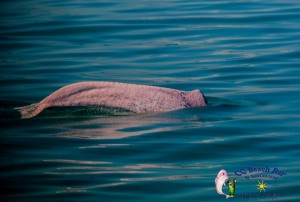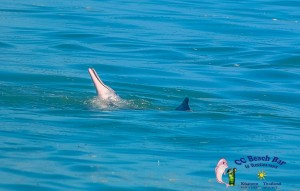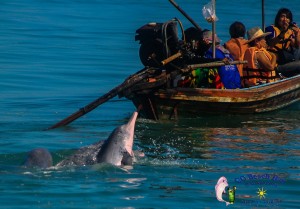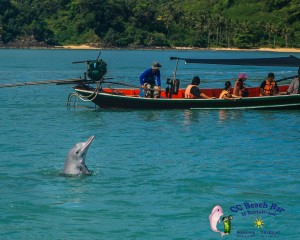Over the years there has been so many different theories about these magnificent creatures who lives in our waters in and around Khanom. Finally, after consulting WDC and from the scientific studies carried out by Walailak University we have the actual facts and details about our Dolphins.
Here is a small extract from an e mail I’ve received from the Head of Science and Research WDC, in which you can see how very important it is to protect these creatures.
The species of dolphin that you see are Indo-Pacific humpback dolphins (now you know this you can probably see the “hump” on the animals in some of your photographs) or to give them their Latin name Sousa chinensis. This following link will take you to some further information on the species – http://uk.whales.org/species-…/indo-pacific-humpback-dolphin
These dolphins need your protection as they MUST be near a freshwater output of sorts and therefore they are restricted to using habitat that has a freshwater input somewhere nearby. They probably have a relatively large home range, so they may roam an area of a few hundred square miles but until further research is undertaken you can’t be absolutely sure.
In the meantime I have some further information for you regarding “your” dolphins by way of a scientific paper that I found written on them, although it was some years ago now. The paper is attached, and notes that there may possibly only be a small population of around 50 individuals. As noted this was some years ago so it would be worthwhile to see if that population has increased or decreased over time and most importantly, with such a small population, to put measures in place to protect them wherever possible and as soon as possible.
Human interactions are usually detrimental to dolphins, for example in Australia a study was done on the same species that found – “evidence suggests that the noise from transiting vessels affects dolphins’ group cohesion. Mother–calf pairs appear to be most disturbed by transiting vessels”
In Hong Kong another study found – “In order to ensure a better environment for the animals, we suggest that proactive conservation measures such as the creation of a marine park, rules and regulations for dolphin watching activities, and regional control of vessel speed should be implemented.”
One of the most damaging human activities for these dolphins is interference by boat traffic therefore a protected area and guidelines would be a good step forward.
Here are the scientific Facts:
Indo-Pacific humpback dolphin
Sousa chinensis
Other names:
• Chinese white dolphin
• Pink dolphin
• Sousa
Maximum length:
• Male: 2.8m
• Female: 2.6m
• Calf: 1m
Maximum weight:
• Male: 280kg
• Female: Unknown
• Calf: Unknown
Diet:
• Fish (nearshore, estuarine and reef)
• Squid
Estimated population:
Unknown
IUCN Listing:
NT (eastern Taiwan Strait subpopulation CR)
CITES Appendix:
I
CMS Appendix:
II
Classification:
There is currently substantial debate by scientists around the world as to the number of species in this genus. In addition to Sousa teuszii, many consider there to be at least three species; Sousa chinensis (Indo-Pacific humpback dolphin) – found from the east coast of India, through the Indo-Malay archipelago and east towards Australia; Sousa plumbea (Indian Ocean humpback dolphin) – found from South Africa to India; and Sousa sahulensis (Australian humpback dolphin) – found in northern Australia. Studies, both morphological and genetic, are currently being carried out to determine the various species-specific ‘splits’. One population of the Indo-Pacific humpback dolphin, living off the industrial west coast of Taiwan, has been recently recognized as a sub-species, S. c. taiwanensis and is rated Critically Endangered.
Appearance:
As suggested by its name, in many parts of its range the Indo-Pacific humpback dolphin has a distinct hump at the base of the dorsal fin. Those in the easterly reaches of the species’ distribution, lack this defining characteristic. The Indo-Pacific humpback dolphin is a medium sized, robust dolphin with a rounded melon that slopes down to the beak. The flippers are broad and rounded, and the beak is long and narrow. There is substantial morphological variation among differing populations, and coloration of this species ranges from white to pink to dark grey. In the western portion of their range, calves are born a light grey color and darken with age. Whereas in the eastern portion of their range calves are born a dark grey and lighten with age. This transition from dark to light coloration results in the animals going through various stages of having dark spots and speckles around the body, all of which fade with age.
Behavior:
Indo-Pacific humpback dolphins are coastal animals, venturing quite far landward into estuaries and mangroves. Their inshore habitats are often turbid waters and thus sound production and reception are crucial for navigation and social contact. In addition to their high frequency echolocation clicks, they are highly vocal, producing whistles and screams singly or in sequences and of varying lengths. They are not known to bow ride very often, but they do breach, lob tail, and even somersault on occasion. They may also be seen sometimes swimming on one side while waving a flipper in the air. They are generally slow swimmers but sometimes will chase each other around in circles at high speed; researchers suggest this may be courtship behavior. The average life-span of an Indo-Pacific humpback dolphin is thought to be approximately 40 years of age.
Distribution:
The species presently referred to as the Indo-Pacific humpback dolphin is known from South Africa to the South China Sea although discrete populations are thought to exist, for example in the Pearl River Estuary, the Persian Gulf and the coastal waters of eastern South Africa. Due to their preference for nearshore waters they are especially at risk from human activities. Bycatch in fishing gear is a serious threat, and many populations have been found to have dangerously high levels of contaminants, which may interfere with reproductive success. Industrial activities and coastal development continue to degrade their habitat and increasing ship and boat traffic is a serious concern for this species. The IUCN currently categorizes the Indo-Pacific humpback dolphin as Near Threatened (2008).
ปลาโลมาหลังค่อมและหลังโหนกอินโด-แปซิฟิก Indo-Pacific
Sousa chinensis
ชื่ออื่น:
•ปลาโลมาขาวจีน
•ปลาโลมาสีชมพู
• เซาซ่า
ความยาวสูงสุด:
•ชาย: 2.8 เมตร
•หญิง: 2.6 เมตร
ลูกแรกเกิด: 1 เมตร
น้ำหนักสูงสุด:
•ชาย: 280 กก
•หญิง: ไม่ทราบ
•ลูกปลาโลมา: ไม่รู้จัก
อาหาร:
•ปลา (ใกล้ชายฝั่งทะเลและแนวปะการัง)
• ปลาหมึก
จำนวนประชากรปลาโลมาโดยประมาณ:
ไม่ทราบ
การจัดหมวดหมู่:
ปัจจุบันมีนักวิทยาศาสตร์จากทั่วโลกกำลังอภิปรายเรื่องจำนวนพันธุ์ในสกุลนี้ นอกเหนือจาก Sousa teuszii หลายคนคิดว่ามีอย่างน้อยสามชนิด; ปลาโลมาหลังโหนกอินโด – แปซิฟิก (Indo-Pacific humpback dolphin) – พบได้จากชายฝั่งตะวันออกของอินเดียผ่านหมู่เกาะอินโด – มาเลย์และทางตะวันออกสู่ประเทศออสเตรเลีย Sousa plumbea (ปลาโลมาหลังค่อมมหาสมุทรอินเดีย) – พบจากแอฟริกาใต้ไปยังอินเดีย; และ Sousa sahulensis (ปลาโลมาหลังค่อมออสเตรเลีย) – พบในภาคเหนือของออสเตรเลีย การศึกษาทั้งทางสัณฐานวิทยาและทางพันธุกรรมกำลังมีการดำเนินการเพื่อหา “การแยก” ชนิดต่างๆ ประชากรปลาโลมาหลังค่อมที่อาศัยอยู่ในแถบอินโด – แปซิฟิคหนึ่งที่อาศัยอยู่นอกชายฝั่งตะวันตกของไต้หวันเป็นที่รู้จักเมื่อเร็ว ๆ นี้ว่าเป็นสายพันธุ์ย่อย S. c. taiwanensis- ใต้หวันซิส และได้รับการจัดอันดับว่าเป็นสัตว์ใกล้สูญพันธุ์
ปลาโลมาเหล่านี้จำเป็นต้องได้รับการคุ้มครองเนื่องจากต้องอยู่ใกล้กับแหล่งน้ำจืดและต้องใช้ที่อยู่อาศัยที่มีน้ำจืดอยู่ใกล้ ๆ พวกเขาอาจมีบ้านที่ค่อนข้างใหญ่บางครั้งพวกเขาชอบว่ายน้ำเที่ยวเล่นไปไกลในพื้นที่ค่อนข้างกว้างยากที่จะติดตาม
และปลาโลมาประเภทนี้ค่อนข้างจะขี้อายไม่ชอบที่จะถูกไล่ตามโดยเฉพาะเวลาที่มีลูกอ่อน
ลักษณะ:
ตามที่แนะนำโดยชื่อของมันในหลาย ๆ ด้านของช่วงที่ปลาโลมาหลังค่อม Indoe-Pacific มีโคกที่แตกต่างกันที่ฐานของครีบหลัง ผู้ที่อยู่ในส่วนตะวันออกของการแพร่กระจายของสายพันธุ์นั้นไม่มีลักษณะที่กำหนดไว้ ปลาโลมาหลังค่อมของ Indo-Pacific เป็นโลมาขนาดกลางและแข็งแรงพร้อมกับแต้มกลมที่ลาดลงไปคล้ายปากนก ครีบมีความกว้างและกลมและมีความยาวและแคบ มีความหลากหลายของรูปแบบทางสัณฐานวิทยาระหว่างประชากรที่ต่างกันและสีของสายพันธุ์นี้มีตั้งแต่สีขาวถึงสีชมพูจนถึงสีเทาเข้ม ในส่วนตะวันตกของช่วงลูกโลมาจะมีสีเทาอ่อนและคล้ำตามอายุ ในขณะที่ในภาคตะวันออกของลูกช่วงของพวกเขาจะเกิดเป็นสีเทาเข้มและสว่างขึ้นตามอายุ การเปลี่ยนผ่านจากสีเข้มเป็นแสงทำให้สัตว์ต่างๆผ่านขั้นตอนต่างๆของการมีจุดด่างดำและจุดทั่วร่างกายซึ่งทั้งหมดจางหายไปตามอายุ
พฤติกรรม:
ปลาโลมาหลังค่อมในมหาสมุทรแปซิฟิกเป็นสัตว์ชายฝั่งที่มีความเสี่ยงที่จะเดินทางสู่ปากอ่าวและโกงกาง ที่อยู่อาศัยฝั่งของพวกเขามักจะเป็นน้ำขุ่นและทำให้การส่วเสียงทักทายพูดคุยเพื่อให้ไม่หลงจากกลุ่มนอกเหนือจากการส่งคลิกเสียงเรียกเข้าที่มีความถี่สูงแล้วพวกเขายังร้องเสียงสูงทำให้นกหวีดและเสียงกรีดร้องเดี่ยวหรือตามลำดับและมีความยาวแตกต่างกัน พวกเขาชอบที่จะว่ายน้ำแบบหงายท้องและกระโดดกางหางและแม้แต่ตีลังกาในบางโอกาส บางครั้งพวกเขาก็อาจจะว่ายน้ำในด้านหนึ่งขณะที่โบกมือลงไปในอากาศ พวกเขามักจะว่ายน้ำช้า แต่บางครั้งจะไล่ตามกันในแวดวงด้วยความเร็วสูง นักวิจัยแนะว่านี่อาจเป็นพฤติกรรมการเกี้ยวพาราสี ช่วงชีวิตโดยเฉลี่ยของปลาโลมาหลังค่อมในอินโดรามาแปซิฟิกคิดว่ามีอายุประมาณ 40 ปี
การกระจาย:
สายพันธุ์ที่ปัจจุบันเรียกว่าปลาโลมาหลังค่อมในอินโดแปซิฟิกเป็นที่รู้จักจากแอฟริกาใต้ถึงทะเลจีนใต้แม้ว่าจะมีประชากรเผ่าพันธุ์ที่คิดไม่ออกเช่นในปากแม่น้ำเพิร์ลอ่าวเปอร์เซียและน่านน้ำชายฝั่งของแอฟริกาตะวันออก เนื่องจากความต้องการของพวกเขาสำหรับน่านน้ำใกล้ชายฝั่งที่พวกเขามีความเสี่ยงโดยเฉพาะอย่างยิ่งจากกิจกรรมของมนุษย์ การจับปลาตกปลาในอุปกรณ์ประมงเป็นภัยคุกคามที่ร้ายแรงและมีปลาโลมาจำนวนมากที่มีสารปนเปื้อนอยู่ในระดับสูงซึ่งอาจส่งผลต่อกระทบในการสืบพันธุ์ กิจกรรมทางอุตสาหกรรมและการพัฒนาชายฝั่งทะเลยังคงลดลงที่อยู่อาศัยของพวกเขาและการเพิ่มจำนวนเรือและเรือเป็นเรื่องสำคัญสำหรับปลาโลมาสายพันธุ์นี้ IUCN ปัจจุบันจัดอยู่ในประเภทปลาโลมาหลังค่อมที่อยู่ในบริเวณใกล้สูญพันธุ์จากการสำรวจในปี (2008)


